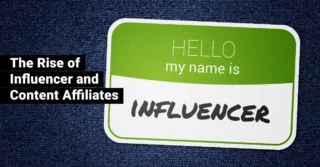Affiliate market’s next chapter is here
Remember the days of visiting the site of one of your favorite bloggers? Perhaps you were looking up a recipe. Maybe you moved into a new home and need home decor ideas. Then again, you could have used a good laugh and tuned in to someone’s trials and tribulations of life, reading daily posts to escape for a bit.
The Early Blogging Days
Bloggers accepted samples of products in exchange for a write up or a mention. But this didn’t pay the bills.
Slowly, those content creators were embedding images and loading text links into their posts, videos and social media links. Favorite products and services began appearing on the web, in the vein of monetizing the time these creators took to craft messages and opinions on a variety of topics. Initially, the practice of accepting payment for writing about a favorite product or service was looked down upon. Bloggers accepted samples of products in exchange for a write up or a mention. But this didn’t pay the bills.
That’s when many bloggers learned that there was a seamless way to promote a product, while not hindering the user experience of the reader. Enter affiliate marketing. Consumers click the link, a purchase is made, a commission would go to the content creator. Done and done.
The Earliest Adopters of Affiliate Marketing
Before the bloggers began creating their own media companies, hundreds of websites were crafted to highlight the best deals of the web. Whether it was your favorite coupon site or cash back experience, these sites were the pioneers of affiliate marketing – and they continue to thrive today.
In both examples, a purchase was influenced by content, a stellar deal or something else that caught the eye of the consumer. The idea of an “influencer” has been around since the first commission was paid.
Instant Brand Celebrities
In the last decade, the term “influencer” grouped content creators with large followings into one marketing bucket. Gamers on Twitch, Beauty Gurus on YouTube, Foodies on Instagram, the categories are endless. The power of social media and quick photo and video editing skills brought a bevy of new entrepreneurs who could connect to audiences quicker than any large brand could. It was marketing gold.
Flat fees and sponsorships abound. Brands and their agencies were reaching out to influencers with large followings. But then it was determined that many Instagram users, for example, could purchase followers. Which would cause engagement levels to go down. In addition, the inflated numbers started a snowball effect of Brands not trusting the influencer. Which meant fewer opportunities for Influencers to have a steady income.
The next evolution of the Brand to Influencer relationship resulted in fewer dollars and/or more ROI metrics needed to prove that the relationship was worthwhile. After that, the pandemic of 2020 struck the economy. Flat fees and sponsorship dollars began to decline. Overall marketing budgets shrunk. The income that Influencers once relied on, usually flat fees, went away.
Enter affiliate marketing.
Give Me a Click, We Can Track It
As demand from the C-Suite drove marketing teams to prove value with every deal, influencers began to shift their efforts to a performance model – getting paid a fee (commission) when an action took place (a sale or lead). This shift not only fell to marketing teams, public relations professionals felt pressure to show value with the press pieces that were pitched to large holding companies like Meredith and Ziff-Davis. The old digital practice of separating Editorial from Advertising went out the window. Today, many larger publications ask for an affiliate link before posting any pitch pieces. Vanity Fair lays it out well:
“Traditional ties to advertisers aside, capital-m media (not excluding Vanity Fair) now heavily relies on the business of directly endorsing consumer goods thanks to affiliate linking, which monetizes every successful rec and has led to the building and branding of entire new verticals in hopes of realizing Wirecutter-size dreams.“
Today, our team works in concert with PR agencies, supplying the appropriate Affiliate link for the piece of content about to go live with Publisher X. The integration works incredibly well.
Introducing the Affluencer
At JEBCommerce, we recognize that there is a specific type of Influencer in the Affiliate Marketing space: The Affluencer.
In a full circle eCommerce moment, Brands are specifically seeking out Influencers in the Affiliate Marketing channel. At JEBCommerce, we recognize that there is a specific type of Influencer in the Affiliate Marketing space: The Affluencer.
The Affluencer is someone who is either very familiar with affiliate marketing and/or is currently an affiliate in a Brand’s program. The Affluencer has a large enough base and level of influence to seek out additional payment elements like slotting fees, an increased commission structure, etc. This category of Influencer may not be as large as the typically defined Influencer that is often managed by the Brand’s PR team.
Recruiting Differences
Affluencers
Affiliate marketers have been recruiting for years. Decades. We know how to use the digital ninjadry to find the right publisher, for the right brand at the right time. Whether it’s looking in the current platform of the program or using a wide variety of new affiliate recruitment tools (tools help us, but we always add extra human context to our searches). Reaching out to an affiliate then delivers an exchange of interest, then ultimately payment structure. Perhaps a slotting fee is included. This is the same method we’d use to find new Affluncers, as they are already familiar with how affiliate programs work.
Affluencers also fit another category: the social media poster who has an organic passion/love for a product or service.
As mentioned in the Vanity Fair piece, Affluencers also fit another category: the social media poster who has an organic passion/love for a product or service. This consumer can also fall into the Affluencer category. Imagine someone who absolutely loves to bake and is using their Instagram feed to highlight their latest creation. Throughout the posting journey, this person is also tagging their favorite products. This is another area where effective outreach can happen and the consumer has the option to join a Brand’s affiliate program seamlessly – using technologies like Link Connector’s Naked Coupon technology. You may have categorized this category as ‘nano influencers’ as well. Smaller following than traditional influencers, but with the potential to drive solid engagement and revenue.
Traditional Influencers
This is the genre of influencers that the industry is accustomed to understanding. Large followings. Mini celebrity. Living in TikTok houses. Fending off Brands and deals quicker than you can say, ‘Swipe Left’. This level of influencer is STILL key to the overall marketing mix, but the time to research, vet, communicate AND form an affiliate marketing relationship is longer than that of the Affluencer. Affiliate agencies are 100% equipped to do this work, but Brands must keep in mind that the time to conduct this work may take time away from standard affiliate marketing tasks. In addition, the matched would-be Influencers may only result in brand awareness (top of funnel) for the Brand versus intent or sales (bottom of the funnel).
This category is usually managed by the Brand’s internal PR team and/or the PR agency. Traditional influencers usually work with Brands on major product launches or have a long-term relationship with the Brand.
Affluencers and Influencers Together, In Harmony
Affluencers are typically further down the funnel, while Influencers focus on the top.
Today’s affiliate marketing space is incredibly complex, but with the right game plan, Brands can have a successful road map of activities: with their PR agency working in concert with the Affiliate Marketing agency. PR teams and Affiliate Marketing agencies should work together, organizing the Influencers and Affluencers by category, but also by where in the funnel they fit. Affluencers are typically further down the funnel, while Influencers focus on the top.
A Bright Future for All
We’ve never been so excited for what the future brings for Affiliate Marketing. As far as digital marketing, it is one of the few areas that continued to thrive in various economic environments. It’s also a place where everybody can have a role, not just the person with a large following. Again, to quote the Vanity Fair piece:
“Across social media, influencers regularly participate in the kind of corporate-sponsorship machinery once only available to bona fide celebrities; you want those abs, that hair? Here’s the coupon code.”
Until the next industry development!






